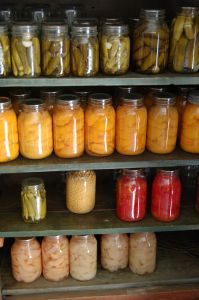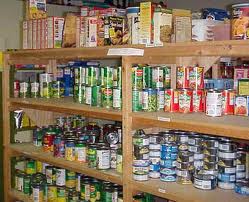Canned Food Storage
Canned food storage is not a subject the average person spends time thinking about. However, during a shortage arising from any type of disaster, a steady food supply will be one of the most critical issues you will face. Canning helps to preserve perishable items far beyond the point at which they would normally begin to break down.
This means that you can eat some of the foods you like even when they are not widely available. More importantly, you will be able to meet your nutritional needs, thereby maintaining your health and keeping your immune system strong.
It is easy to dismiss the idea of a widespread food shortage as being farfetched. The truth is, any number of situations can compromise the supply. Whenever there is a natural disaster, feeding survivors is one of the first areas of concern.
The food supply could also be deliberately exposed to contaminants, as would be the case in a terrorist attack. These are reasons why canned food storage is an issue more people should be paying attention to.
Doing it Yourself
Buying foodstuff in cans is not the only way to create your stockpile of nutritious items. While many people might balk at the idea of creating their own small canning operation it is not as difficult as you might think. If you are new to canning, start researching what you will need and ask questions if you are unsure. The many forums about surviving and canning are worth joining. Some things to keep in mind for this type of canned food storage are:
- Use only the freshest fruits and vegetables
- Make sure that your containers are clean
- Use glass jars instead of plastic, since plastic containers can leach chemicals into the foodstuff. Ensure that the lids you use are free of rust and not bent.
The most expensive piece of equipment you will probably need is a pressure canner. You can forego this piece of equipment in the beginning of your canning operation if you want to start with water-bath canning, which is only suitable for acidic foods like tomatoes or pickles. However, for meat, and non-acidic foods, you’ll definitely want a pressure canner.
For the best results, and to improve shelf life of the foodstuff, put food items in individual containers and seal them so that they are airtight. Place the jars in the pot or pressure canner, and bring the water to a boil. The heat will drive the air from the bottles, creating a vacuum. This airless environment will not only retard the growth of bacteria, it will adequately preserve the foodstuff for a long time.
Storing Store Bought Canned Food
Many people buy food in tins in the supermarket for the sake of convenience. This type of foodstuff can be handy to have around in an emergency. If you keep them under the right conditions, tin products from the store can remain safe to eat for years. It is important to buy only what you can adequately store.
Creating extra storage space is always an option, but without it, you face the risk of keeping the cans in unsuitable environmental conditions. If any damage occurs, there is the risk of contamination of the provisions. When storing food in cans, you need:
- Constant room temperature is best, as high or fluctuating temperatures can lead to spoilage
- Make note of the expiration date, and buy only items that you can keep for the longest possible period
- Create a labeling system that allows you to know which items are close to their expiration date so you can use them first. This will also help you to replenish your stock as necessary, following the “first in-first out” rule.
- Keep your canned foods away from light
Typically, it is best to consume canned tomatoes or tomato-based foods within one year after purchase. Meat or fish, on the other hand, tend to have the longest storage times of commercially canned foods.
If using store bought items, examine the cans for signs of rust or damage. If any dents or other damage is noticed, do not buy the products. Read the label for any special instructions regarding preparation or canned food storage. For example, light can affect the taste and texture of foodstuff stored in glass containers so these need to be in a dark cool place.
It is wise in the event of a shortage to be mindful of the way you use your food supply. As such use containers that have enough supplies for one meal for a family rather than using a large one as opening and closing containers will lead to spoilage.
Canned goods can also be bartered or traded during a serious disaster, so keep your storage area secure and known to only trusted people in your group.
Return from Canned Food Storage to DIY Survival Food







New! Comments
Have your say about what you just read! Leave me a comment in the box below.